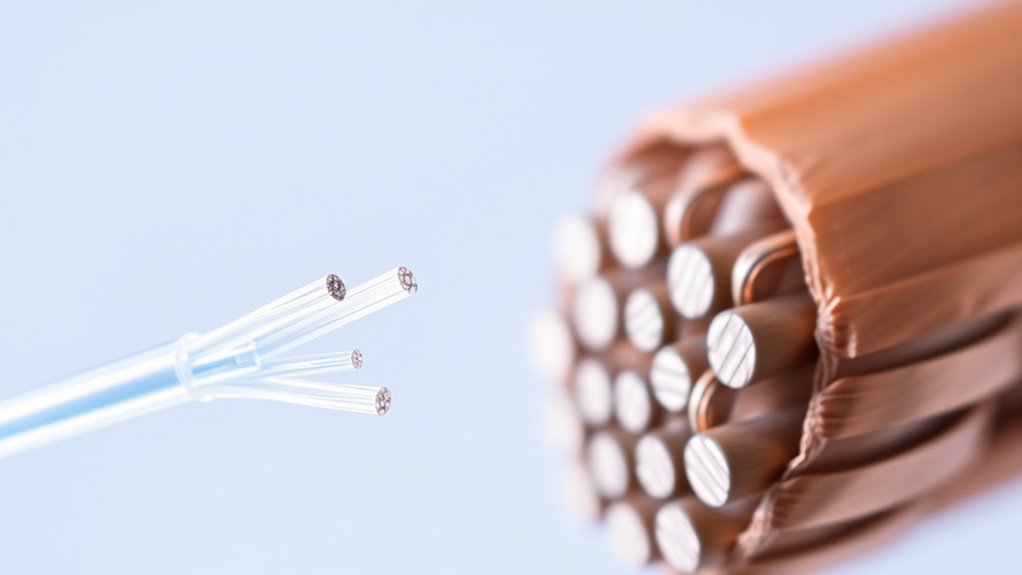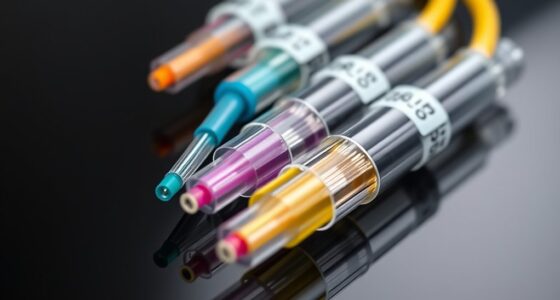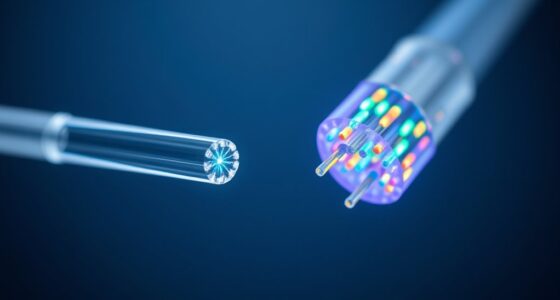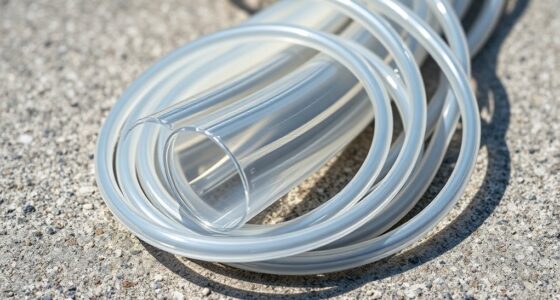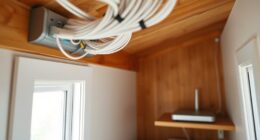Fiber optic cables offer faster speeds, higher bandwidth, and better reliability than copper cables, making them ideal for long-distance and high-demand data transmission. They are immune to electromagnetic interference and provide a cleaner connection, but require specialized installation and cost more upfront. Copper cables are more affordable and easier to install, though they suffer from slower speeds and interference issues. To discover which option suits your needs best, explore the detailed advantages and disadvantages further.
Key Takeaways
- Fiber optics offer higher speeds and bandwidth, ideal for long-distance, high-demand data transmission.
- Copper cables are more affordable and easier to install, making them suitable for smaller or budget-constrained projects.
- Fiber optics are immune to electromagnetic interference, providing more reliable and cleaner signals.
- Copper cables are susceptible to interference, which can degrade performance and data quality.
- While fiber optics have higher initial costs, their long-term benefits include greater durability and performance.
Advantages and Disadvantages of Fiber Optic Cables

Fiber optic cables offer significant advantages over traditional copper cables, primarily because they transmit data as pulses of light, which allows for faster speeds and higher bandwidth. However, they do have some disadvantages. One notable issue is signal interference, which is virtually nonexistent with fiber optics, ensuring a cleaner, more reliable connection. On the downside, installation complexity can be a challenge; fiber optic cables require specialized tools and skills, making setup more difficult and costly. Bending or pulling the cables improperly can also damage them, leading to potential disruptions. Additionally, the installation process for fiber optics can be more time-consuming compared to copper wiring. Proper handling and installation safety are crucial to prevent damage during setup. Furthermore, the cost of fiber optic deployment can be higher upfront, which may impact budget considerations for certain projects. While fiber optics excel in performance and immunity to interference, their installation process demands careful handling and expertise. You need to weigh these factors when considering fiber optic cables for your network.
Advantages and Disadvantages of Copper Cables

Copper cables have been a reliable choice for networking and communication systems for decades, offering several practical advantages. They are cost-effective, easy to install, and compatible with existing infrastructure. However, they are susceptible to signal interference, which can degrade data quality. Additionally, installation complexity increases over longer distances due to signal attenuation. To highlight these points:
| Advantage | Disadvantage |
|---|---|
| Cost-effective | Signal interference |
| Easy to install | Installation complexity |
| Widely compatible | Limited bandwidth |
| Flexible and durable | Prone to electromagnetic noise |
| Suitable for short distances | Signal degradation over distance |
While copper cables are accessible and reliable, their limitations in interference and distance make fiber optics preferable for high-speed, long-range applications. Understanding electromagnetic interference can help in selecting the most suitable cabling solution. Moreover, advancements in cable shielding techniques have been developed to mitigate some of these issues. These innovations contribute to improved signal integrity, especially in environments with high electromagnetic activity. Additionally, ongoing research into noise reduction methods continues to improve copper cable performance in challenging environments.
Frequently Asked Questions
How Do Fiber Optic and Copper Cables Compare in Cost Over Time?
Over time, fiber optic cables tend to be more cost-efficient due to their higher durability and faster data transmission, which leads to long-term savings. Although initial installation costs are higher, you save on maintenance and upgrade expenses later. Copper cables, on the other hand, have lower upfront costs but may require more frequent replacements and repairs, making fiber optics the better choice for cost efficiency and long-term savings.
Which Cable Type Is More Resistant to Environmental Damage?
Imagine a coastal data center facing salty air and humidity. You’d find fiber optic cables more resistant to environmental damage because of their superior environmental durability and physical resilience. Unlike copper, which corrodes and degrades faster in harsh conditions, fiber optics withstand moisture, temperature fluctuations, and physical stress better. For outdoor or challenging environments, fiber optic cables offer a more reliable, long-lasting solution, minimizing maintenance and downtime.
Can Existing Infrastructure Support a Switch From Copper to Fiber?
Your existing infrastructure may not support a switch from copper to fiber without significant upgrades. You’ll need to assess infrastructure compatibility, including conduit sizes and connection points, to determine if upgrades are feasible. Upgrading challenges include costs, installation complexity, and potential service disruptions. it is crucial to evaluate whether your current setup can accommodate fiber optic cables or if substantial modifications are necessary, which might impact your timeline and budget.
What Are the Safety Considerations for Installation and Maintenance?
When installing and maintaining fiber optic or copper cables, you need to stay vigilant about safety. Always disconnect power before working to prevent electrical shock, and handle cables carefully to avoid fire hazards caused by damage or improper installation. Use appropriate protective gear, follow safety protocols, and guarantee proper grounding. Regularly inspect equipment for wear or fraying, reducing risks of electrical shock and fire hazards during maintenance.
How Do Signal Degradation Rates Differ Between the Two Cables?
You’ll notice that fiber optic cables experience much lower signal attenuation over long distances compared to copper cables. They are less susceptible to interference, maintaining signal integrity better. Copper cables, however, suffer from higher interference susceptibility, which causes faster signal degradation, especially over extended runs. This means fiber optics keep your data clearer and more consistent, while copper cables may require repeaters or amplifiers to compensate for faster signal degradation.
Conclusion
When choosing between fiber optic and copper cables, it’s clear fiber offers higher speeds and better security, but at a higher cost. Copper cables remain affordable and easier to install, making them suitable for smaller setups. Did you know that fiber optic cables can transmit data over 40 kilometers without significant signal loss, compared to just 100 meters for copper? This shows fiber’s advantage for long-distance, high-speed networks, making it a future-proof choice if you need top performance.
